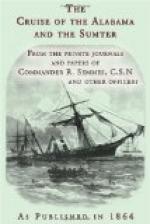The bill of lading for the 225 kegs of nails has a similar indorsement, except that it is asserted that the whole of the property belongs to subjects of the King of Italy. It is not sworn that the property belongs to Castarelli, the consignee, and for aught that appears, Castarelli is the agent of the shipper to receive this consignment on his, the shipper’s account. The presumption being, that notwithstanding a consignment in due form by an enemy shipper to a neutral, the property is enemy’s property, until the contrary be shown. The consignment alone does not show the property to be vested in Castarelli, and the certificate does not indicate him as the owner. Although Castarelli could demand possession of the goods, under this consignment, he could not claim to hold them as his property under the certificate. There is, therefore, no evidence to show that he is not the mere agent of the shipper. What renders this consideration still more clear is, that if the goods had really belonged to Castarelli, it would have been so stated in the certificate. Why say that the goods belonged to “subjects of the King of Italy,” when the consignee was the real owner?
The property shipped by H. Jas. Burden consists of 998 barrels of flour and 290 boxes of herrings, and is consigned to Charles B. Blandly, Esq., at Funchal, Madeira. The shipper, H.J. Burden, makes the following affidavit before the British consul in New York, to wit: “That all and singular the goods specified in the annexed bill of lading, were shipped by H.J. Burden, in the barque Lauretta, for and on account of H.J. Burden, subject of Her Britannic Majesty.” Now, Burden may be a very good subject of Her Britannic Majesty, but he describes himself as of 42 Beaver Street, New York, and seems to lose sight of the fact, that his domicile, for the purposes of trade, in the enemy’s country, makes him an enemy, quoad all his transactions in that country. Further: if the H.J. Burden, the shipper, is not one and the same person with the H.J. Burden for whom the property is claimed, then there is nothing in the papers to show that property is vested in the latter, since it is not consigned to him, nor is it shown that the consignee, Charles B. Blandly, Esq., is his agent. The presumption, in the absence of proof, is, that the consignee is the agent of the shipper.
* * * * *
Wednesday, October 29th.—* * * * At 10 A.M. hove to; let down the propeller, and put the ship under steam. Chased and overhauled a Dutch barque, and towards nightfall came up with the United States brigantine, Baron de Custine, from Bangor, with lumber for Cardenas. The vessel being old, and of little value, I released her on ransom bond, and converted her into a cartel, sending some forty-five prisoners on board of her, the crews of the last three ships burned.




